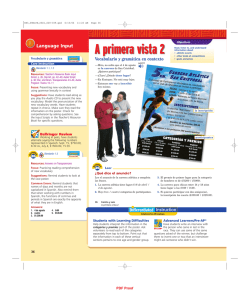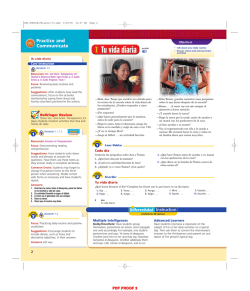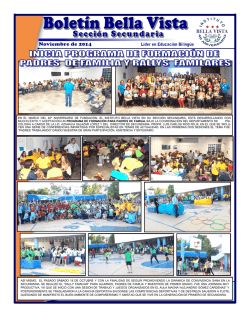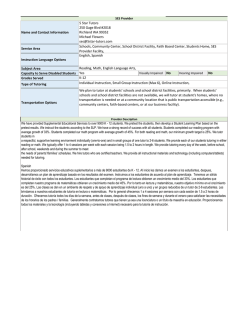
Practice and Communicate
6/21/06 10:11 AM Manos a la obra 2 Standards: 1.2, 3.1 28 ANSWERS Focus: Categorizing new vocabulary Suggestions: When checking answers with students, ask them to say why the word they chose does not belong with the others. Answers: 1. d 2. a 3. d 4. c 5. d 6. c Bellringer Review Have students unscramble these words to make a logical sentence. tivid ad Ac (Answer: El político exageró los gestos y la gente se rió mucho.) Standards: 1.2, 2.2 29 b. el ritmo c. el compás d. el gesto b. la danza c. el paso d. bailar 3. a. la actuación b. el gesto c. interpretar d. el conjunto 4. a. el escenario b. realizar c. la entrada d. la interpretación 5. a. el escritor b. el poeta c. el poema d. el micrófono 6. a. el tambor b. la trompeta c. el actor d. el piano tivid 29 Leer/Escribir Una reseña Loreto Michea, un crítico, escribe sobre el popular programa de tele, Sábado Gigante. Completa la reseña con la palabra correcta. “Sábado Gigante no es sólo un programa familiar. Es un lugar donde la audiencia ___ 1___ . (actúa / se identifica) con otros hispanohablantes, sin importar en qué lugar de América viven. Pero los concursos, la música, el humor, ___ 2___ . (los pasos / las actuaciones) y las entrevistas, no son los elementos del programa que más ___ 3___ . (se destacan / se exageran). Don Francisco, su presentador, es la clave (key). Es un actor muy ___ 4___ . (aburrido / cómico) y energético que utiliza sus ___ 5___ . (libros / gestos), su voz y su picardía (wit) para divertir al público. Su ___ 6___ . (entusiasmo / paso) es impresionante, Suggestions: Remind students that looking over the entire review first will give them an idea of what it is about and help them select the correct answers. Answers: gestos exagera interpretan actuar Extension: Invite students to work in groups. Have them choose a popular TV show they all know and make critical comments about it. Leer/Escribir 2. a. el poema ANSWERS 5. 6. 7. 8. 86 y cuando los cantantes ___ 7___ . (interpretan / actúan) las canciones populares o los artistas aparecen en el escenario para ___ 8___ . (exagerar / actuar), la energiá de don Francisco inspira al público.” ochenta y seis Manos a la obra 2 Students with Learning Difficulties Encourage students to bring in examples of their own favorite music CDs. After copying the chart in Actividad 31 on p. 87, guide students to take appropriate notes for each of the songs they hear. Have them use these to conduct the partner conversations. 86 • Review uses of ser and estar 1. a. la melodía Focus: Practicing new vocabulary in a cloze activity se identifica las actuaciones se destacan cómico • Express your opinion about a dance, music, or theater performance Escribe en una hoja de papel los números del 1 al 6. Para cada grupo de palabras, escribe en la hoja la letra de la palabra que no está relacionada con las otras. Después, haz una lista de las palabras que no están relacionadas con las demás y escribe una frase con cada una. Resources: Answers on Transparencies 1. 2. 3. 4. • Talk about different forms of entertainment ¡Quita la palabra! ad los / rió / exageró / la / se / mucho / el / gestos / político / gente / y 28 Objectives • Practice verbs that have different meanings in the preterite and the imperfect tivid ad Resources: Answers on Transparencies Vocabulario y gramática en uso Ac tivid ad Ac Practice and Communicate Page 86 Ac RE3_08NLTE_Ch02_086-097.qxd Advanced Learners/Pre-AP* Challenge students to write six sentences, one for each item in Pre-AP* Actividad 28. Each sentence should use all of the words in the row—including the word that does not belong—in a way that makes sense. 6/30/06 3:46 PM Page 87 Practice and Communicate tivid 30 Escribir/Hablar Un espectáculo de flamenco Focus: Using new vocabulary and structures in a guided conversation Suggestions: Encourage students to build more than one question-and-answer exchange around each word or expression. Make sure they switch roles, so that all students have a chance to practice both asking and answering. al frente a la izquierda los bailarines cantar sentado el paso Answers will vary. Ac Escribir/Hablar tivid Standards: 1.1, 3.1 ad 31 Standards: 1.1 30 tivid ad Ac el fondo al lado el micrófono tocar la guitarra el cantante parado el escenario tivid ad Imagina que estuviste en el espectáculo de flamenco de la ilustración y describe la escena. Escribe frases en pretérito o imperfecto. Puedes usar las palabras y frases del recuadro. Luego, otro(a) estudiante te va a hacer preguntas sobre lo que escribiste. Modelo A —Vi un espectáculo en el escenario. B —¿Que clase de espectáculo fue? A —Fue un espectáculo de flamenco. Ac ad Ac RE3_08NLTE_Ch02_086-097.qxd 31 ¡Viva la música! Focus: Practicing new vocabulary in a guided conversation ¿Cuál es tu disco compacto favorito? ¿Por qué? Piensa en algunas palabras que describan los diferentes elementos de tu canción o disco compacto favorito. En una hoja de papel, dibuja y completa una tabla como la siguiente. Elemento Suggestions: Explain to students that they should choose just one favorite CD or song for the chart and to talk about with their partner. Estudiante A Disco compacto/Canción ¿Qué te parece . . . ? el compás / el ritmo ¿Cómo suena . . . ? la melodía ¿Cómo es . . . ? la voz ¿Qué canción tiene mejor . . . ? Common Errors: Some students make the assumption that all Spanish nouns ending in -a are feminine. Remind them that many nouns ending in -a, such as el tema, el programa, and el problema, are masculine. los instrumentos Estudiante B la letra el tema Habla con otro(a) estudiante sobre tu canción o disco compacto favorito. Usa las palabras que escribiste en la tabla. interesante original alegre aburrido(a) tradicional Modelo A —¿Qué te parece la melodía de la primera canción del disco compacto de Shakira? B —La melodía es muy original, me gusta mucho. A —¿Cómo suenan las guitarras en esta canción? B —Suenan demasiado alto, no se oye la voz. Answers will vary. largo(a) corto(a) alto(a) bajo(a) rápido(a) lento(a) ochenta y siete Capítulo 2 Teacher-to-Teacher 87 Enrich Your Teaching Additional Resources Resources for All Teachers WAV Wbk.: Audio Act. 3, p. 24 Teacher’s Resource Book: Audio Script. p. 71, Communicative Activity BLM, pp. 79–80 • Audio Program: Track 18 • Culture Note Flamenco is an art form comprised of three parts: the dance, the song, and the music of the guitar. Flamenco enjoyed its “Golden Age” in the late nineteenth and early twentieth century. During this era, the art was developed in Spain's many cafés cantantes or musical cafés. Invite students to share with the class a favorite art work or artist. They might play part of a song, read a poem or a rap, or show a favorite scene from a film, and then tell about it and what it means to them. Aside from any English involved, their presentations should be in Spanish. Then take the assignment one step further: request that they spend equal time showing and telling about an art form or artist from the Spanish-speaking world. • During the twentieth century, the popularity of flamenco grew, and artists made their way from small cafés to large theaters and concert stages. Internet Search Assessment Keyword: • música flamenca Prueba 2-6: Vocab. Production, pp. 48–49 87 RE3_08NLTE_Ch02_086-097.qxd 6/21/06 10:11 AM Page 88 Practice and Communicate Ser y estar Remember that ser and estar both mean “to be.” They are used in different situations and have different meanings. GRAMMAR Core Instruction Standards: 4.1 Use ser: Use estar: • to describe permanent characteristics of objects and people • to describe temporary characteristics, emotional states, or conditions Resources: Voc. and Gram. Transparency 63 Esa canción es muy original. Suggestions: Give other examples where the adjective has different meanings when used with ser or estar: El niño es (está) malo. The boy is bad (sick). Las manzanas son (están) verdes. The apples are green (unripe). • to indicate origin, nationality, or profession Mi tía es escritora. Es de Madrid. • to indicate when and where something takes place El concierto es el viernes. Es en el teatro. El teatro está cerrado a esta hora. Los actores están muy nerviosos. • to indicate location El conjunto está en el escenario. • to form the progressive tense El bailarín está interpretando a Cabral. • to indicate possession ad Ac La guitarra es de Elisa. tivid Some adjectives have different meanings depending on whether they are used with ser or with estar. Standards: 1.2 32 La bailarina es bonita. The dancer is pretty. (She’s a pretty person.) La bailarina está muy bonita hoy. The dancer looks pretty today. (She doesn’t always look this pretty.) ANSWERS El cómico es aburrido. (He is boring.) El cómico está aburrido. (He is bored.) Resources: Answers on Transparencies El cantante es rico. (He is wealthy.) El postre está rico. (It tastes very good.) Common Errors: Correct usage of ser and estar is difficult for any English speaker learning Spanish. Tell students that correct usage will come with patience and practice. Answers: tivid ad Ac 1. es 2. está 3. es 4. son 5. están 6. son 7. están 8. estamos 9. están Standards: 1.2 33 Resources: Teacher’s Resource Book: Audio Script, p. 71; Audio Program: Track 19; Answers on Transparencies tivid ad Suggestions: Encourage students to complete the activity without looking back at the Gramática for each item. Once they are finished, they can check their answers against the rules in the Gramática and make any necessary changes. Ac Focus: Practicing uses of ser and estar in a cloze exercise 32 Leer/Escribir Invitación a Caras y Caretas El secretario del club de teatro mandó esta invitación por correo electrónico. Completa la invitación con la forma correcta de ser o estar. ! Atención compañeros y compañeras! El jueves a las 3:30 ___ 1___ . la reunión de Caras y Caretas. Nuestro club 3___ . un club ___ 2___ . en la sala 28, en el segundo piso. Caras y Caretas ___ que trabaja para realizar comedias y tragedias de España y América Latina. Los miembros ___ 4___ . estudiantes, profesores y otros que ___ 5___ . interesados en hacer teatro. Los invitados de honor ___ 6___ . Raúl Moreno y Eva Díaz, dos jóvenes poetas mexicanos que ahora ___ 7___ . estudiando en Nueva York. Nosotros ___ 8___ . muy orgullosos de la obra de estos jóvenes. Todos ustedes ___ 9___ . invitados a conocerlos. ¡Los esperamos! 88 ochenta y ocho Manos a la obra 2 Focus: Listening for and using forms of ser and estar Suggestions: Make sure students answer in complete sentences. Answers: 1. 2. 3. 4. 5. 6. 7. Es argentino. Es músico. Está en Chicago para dar un concierto. Los otros miembros del conjunto están con él. El cantante es colombiano. El concierto es mañana por la noche. Está un poco nervioso. 88 Heritage Language Learners Students with Learning Difficulties Have students draft an e-mail message extending an invitation to a performing arts event in their heritage country. Instruct students to identify their audience. They might be writing to a close friend or to the entire mailing list of the performing arts institution. Remind them to tailor their language accordingly. Have students write the verb forms es and está on two separate index cards. Help them reinforce the distinction between the forms of these two verbs that both mean “to be.” Provide sentences in which students must fill in the blank by holding up the appropriate card. Ask them to explain each choice. Page 89 jed-0272 Escuchar Practice and Communicate tivid Leer/Escribir/Hablar 34 Escena de teatro Escucha la entrevista en la radio con Carlos Galán y luego contesta las preguntas. Tú y otro(a) estudiante están hablando de una visita que hicieron al teatro. Túrnense para combinar palabras o expresiones de las dos listas y escriban frases completas con el imperfecto de ser o estar. Usen las formas correctas de los adjetivos. 1. ¿De dónde es Carlos? 2. ¿Cuál es su profesión? 3. ¿Por qué está en Chicago? 6. ¿Cuándo es el concierto? 7. ¿Cómo se siente Carlos? 1. las bailarinas a. muy difícil 2. el micrófono b. nervioso 3. el teatro c. en la calle Bolívar 4. los pasos del tango d. muy bonito 5. la melodía e. el viernes a las ocho 6. el concierto f. entusiasmado con el 5. ¿Quién es colombiano? 7. los actores 8. nosotros espectáculo g. alto Ac ad tivid En el museo las estatuas me miran. Estoy perdido. Poeta por un día Después de escribir tu haiku, haz un dibujo para ilustrarlo. Ahora estás listo(a) para presentar tu haiku a la clase. Explica en qué te inspiraste para escribirlo y muestra la ilustración. .. Ac tivid Standards: 1.2, 1.3, 3.1 35 Focus: Practicing using the preterite vs. the imperfect tense Suggestions: Display students’ finished haikus in the classroom. Answers will vary. Más práctica Practice Workbook, p. 30: 2–10 WAV Wbk., Writing, pp. 30–31 ● Guided Practice: Grammar Acts., pp. 71–72 ● Real. para hispanohablantes, pp. 58–61 ● ● Chapter Project For: Ser and estar Web Code: jed-0207 ochenta y nueve Capítulo 2 89 Enrich Your Teaching Resources for All Teachers Culture Note Haiku grew out of a Japanese style of poetry in which people would play a kind of word game. One person would begin with a three-line poem based on the idea of a season. The first line would have five syllables, the second line seven, and the third line five. This opening verse was called a hokku. Then another person 1. A —¿De qué nacionalidad eran las bailarinas? B —Eran argentinas. 2. A —¿Dónde estaba el micrófono? B —Estaba al fondo del escenario. 3. A —¿Dónde estaba el teatro? B —Estaba en la calle Bolívar. 4. A —¿Cómo eran los pasos del tango? B —Eran muy difíciles. 5. A —¿Cómo era la melodía? B —Era muy bonita. 6. A —¿De qué era el concierto? B —Era de música argentina. 7. A —¿Cómo eran los actores? B —Eran muy altos. 8. A —¿Cómo nos sentíamos? B —Estábamos entusiasmados con el espectáculo. ad Los poemas haiku tienen tres líneas. La primera tiene 5 sílabas, la segunda tiene 7 y la tercera tiene 5. Por lo general, hablan de la naturaleza, escenas de la vida, las artes y los sentimientos que inspiran. Los sentimientos se expresan de una manera breve y sencilla. Piensa en un lugar, cosa o situación que te gusta o no te gusta. Por ejemplo, un baile, una fiesta, un museo. ¿Qué sientes cuando estás allí? Mira el ejemplo e inspírate para escribir tu propio haiku. Usa el presente de ser o estar para escribir tus frases, y no olvides que necesitas 5, 7 y 5 sílabas. Resources: Answers on Transparencies Answers will vary. The following are sensible uses of the cues given: i. argentino Escribir/Dibujar/Hablar ANSWERS Suggestions: Have partners share their exchanges with the class. Ask students which rule determined their use of ser or estar. h. fondo del escenario 35 Standards: 1.1 34 Focus: Determining use of the preterite forms of ser and estar Modelo el cantante / alto y guapo A —¿Cómo era el cantante? B —El cantante era alto y guapo. 4. ¿Quiénes están con Carlos? tivid ad Entrevista en la radio Ac 3:46 PM Ac 33 6/30/06 ad tivid ad Ac RE3_08NLTE_Ch02_086-097.qxd Students can perform Step 4 at this point. Be sure they understand your corrections and suggestions. (For more information, see p. 62-a.) Assessment • • Quiz on PresEXPRESS Prueba 2-7: Ser y estar, p. 50 would respond with two lines of seven syllables each. These lines would be related to the theme of people. Today the formalized style of haiku has spread and gained popularity around the world, and haiku can be found written in a multitude of languages, including Spanish. 89 RE3_08NLTE_Ch02_086-097.qxd 6/21/06 10:11 AM Page 90 Practice and Communicate Gramática Verbos con distinto sentido en el pretérito y en el imperfecto Gramática Gramática A few Spanish verbs have different meanings in the imperfect and the preterite tenses. GRAMMAR Core Instruction saber Standards: 4.1 IMPERFECT PRETERITE knew found out, learned ¿Sabías que el concierto empezaba tarde? Resources: Voc. and Gram. Transparency 64 conocer Suggestions: Ask students to write other sentences that use the five verbs in the two tenses. Since meaning is the key here, allow them to think of an idea in English first if necessary, and then convert the idea to a Spanish sentence. querer no querer refused to No querían ver esa obra de teatro. No quisieron ver esa obra de teatro. was able to, could managed to, succeeded in Ella pudo aprender la letra de esa canción. Answers: Step 1 5. 6. 7. 8. sabía pudo quería quise Step 2 1. La conoció el verano pasado. 2. Rita dijo que quería comer algo. 3. Ricardo estaba enojado porque Rita tenía una cita con otro muchacho. tivid ad Suggestions: Have students do the activity on their own. Then have volunteers take turns reading it aloud. Ask each volunteer to say in English what the sentence means, based on the Spanish verb form he or she chose. Ac ad Ac didn’t want to Yo quise comprarlas, pero me enfermé. ANSWERS Focus: Practicing verbs whose meanings change depending on tense conocía conocí quería podía Luis la conoció el año pasado. tried to Ella podía aprender la letra de la canción. Resources: Answers on Transparencies 1. 2. 3. 4. wanted to Luis quería comprar las entradas hoy. Standards: 1.2, 1.3 36 met (somebody) for the first time Pedro conocía muy bien a esa actriz. poder tivid knew (somebody) Sí, supe ayer que empezaba tarde. 36 Leer/Escribir Una cita con Rita A veces las citas no resultan como queremos. Lee estos párrafos sobre la cita que Ricardo tuvo con Rita y complétalo con el pretérito o el imperfecto de los verbos entre paréntesis. Yo no ___ 1___ . (conocer) bien a Rita. Era sólo nuestra segunda cita. Recuerdo que la ___ 2___ . (conocer) el verano pasado en una clase de danza. Ella ___ 3___ . (querer) aprender salsa, pero no ___ 4___ . (poder) seguir bien los pasos. Yo le pregunté si ___ 5___ . (saber) los movimientos de baile. Ella me dijo que no. Entonces, yo la ayudé y al final ella ___ 6___ . (poder) aprenderlos. Cuando salimos de la escuela de danza, Rita me dijo que ___ 7___ . (querer) comer algo. Después, me dijo que ya era tarde y que tenía una cita con otro muchacho. Me invitó a ir con ellos, pero yo no ___ 8___ . (querer) ir. Ya estaba bastante enojado. ¡Nunca más salí con ella! Ahora, responde a las siguientes preguntas. 1. ¿Cuándo conoció Ricardo a Rita? 2. ¿Qué pasó cuando salieron de la escuela de danza? 3. ¿Por qué estaba enojado Ricardo? Teacher-to-Teacher Have students work in pairs to select a song in Spanish and create a list of similarities and differences to a similar song in English. Have them play both songs for the class, present their findings, and encourage the class to add to the list. 90 90 noventa Manos a la obra 2 Heritage Language Learners Students with Special Needs Have students write out the lyrics to a favorite Spanish-language song on poster board or chart paper. Invite them to read the lyrics aloud for the class and explain unfamiliar vocabulary, then play the song so their classmates can listen and read along. Help students with hearing impairments experience the rhythms of salsa, merengue, and tango by exhibiting video or live examples of the dances associated with these musical genres. Encourage students to move, clap, or drum to the beat of the movements they are seeing. RE3_08NLTE_Ch02_086-097.qxd 6/30/06 3:46 PM Page 91 Practice and Communicate La salsa tiene origen en el son, una mezcla de ritmos africanos y europeos que nació en Cuba. Al principio, el son se interpretaba con tambores y maracas. Luego se añadieron otros instrumentos como el bajo (bass) y la guitarra. El término salsa empezó a usarse en los años sesenta en Nueva York y sirve para definir una música que es mezcla del son cubano y otros ritmos del Caribe. La salsa es uno de los bailes más populares en los Estados Unidos. Standards: 1.1, 1.2, 2.2, 3.1 Suggestions: Ask if any students know how to dance la salsa and if they would volunteer to give a demonstration. Extend this invitation to any colleagues. Some students or teachers might even be willing to give a salsa lesson, which would provide an excellent context for real-life use of chapter vocabulary related to dance and music. • ¿Qué nombres de cantantes o grupos de salsa conoces? tivid 37 Escribir/Hablar Y tú, ¿qué dices? Answers will vary. 4. Piensa en una ocasión en que no quisiste hacer algo. ¿Qué fue? 2. ¿Hay algo que nunca pudiste hacer bien? ¿Por qué no podías hacerlo? 5. ¿Conocías ya a muchos(as) de tus compañeros(as) cuando empezaste esta clase? 3. ¿Qué poemas o canciones sabías de niño(a)? ¿Los sabías de memoria? 6. ¿Conociste a alguien famoso(a) alguna vez? ¿A quién? ¿Cómo sabías que era famoso(a)? En voz alta 1 compose 2 complex “Amigos” de Juan Luis Guerra Answers will vary. Yo soy tu amigo cuando a nadie le interesas tan sólo llámame y enseguida tocaré a tu puerta. Yo soy tu amigo cuando buscas y no encuentras tan sólo llámame y estaré a tu lado cuando quieras. Somos el viento que despierta el alba dos nubes blancas bajo la ventana yo soy tu carga que no pesa nada tú eres el río donde bebo el agua. Tómalo todo, pide lo que quieras haz el camino y seguiré tus huellas. noventa y uno Capítulo 2 Resources for All Teachers Culture Note Merengue is a rural music with roots in the Dominican Republic. Traditionally bands were composed of an accordion, a saxophone, a bass, a tambora drum, and a guayano—a metal scraper. Today however, merengue bands often achieve a big-band sound through the use of multiple saxophones, electric guitars, keyboards, and synthesizers. Internet Search Standards: 1.1, 1.3 Suggestions: As students hold their discussions based on the questions, have them write down any of their partner’s responses that strike them as interesting. After the paired discussions, have students share with the class one interesting fact that they learned about their partner. En español, las letras b y v se pronuncian igual. Al principio de una palabra, el sonido es similar a la b en boy. En otras posiciones, el sonido es más suave. Enrich Your Teaching 37 Focus: Practicing verbs whose meanings change depending on tense ¿Recuerdas? Juan Luis Guerra creció escuchando la música popular de la República Dominicana y a los Beatles en la radio. Más tarde, asistió al Conservatorio Nacional y al Berklee College of Music de Massachusetts, donde recibió la influencia del jazz. Con todas esas experiencias, Guerra comenzó a componer1 canciones de merengue, el popular ritmo dominicano, que eran perfectas para bailar pero que tenían una música, y sobre todo una letra, mucho más rica y compleja2 que la de los merengues tradicionales. Escucha este fragmento de la letra de una canción de Juan Luis Guerra y luego trata de repetirla en voz alta. tivid ad 1. Piensa en un momento en que quisiste hacer algo pero no pudiste. ¿Qué fue? Ac ad Ac • ¿Por qué crees que la salsa tiene tanto éxito en los Estados Unidos? En voz alta Core Instruction Standards: 1.2, 3.1, 2.2, 3.2, 5.2 Resources: Voc. & Gram. Transparencies: Map 16; Teacher’s Resource Book: Audio Script, pp. 71–72; Audio Program: Track 20 Suggestions: Show Voc. and Gram. Transparency 16 and ask a volunteer to locate la República Dominicana. 91 Before having students recite the lyrics, direct their attention to the information in the ¿Recuerdas? Allow them a few minutes to practice with a partner. Invite students to talk about how the images in the third stanza demonstrate friendship. Keywords: Juan Luis Guerra, música merengue 91 RE3_08NLTE_Ch02_086-097.qxd 6/21/06 10:11 AM Page 92 Standards: 1.1, 1.2, 1.3, 2.2, 3.1 ad Ac tivid 38 Ac 38 Estrategia ANSWERS tivid ad Practice and Communicate Leer/Escribir/Hablar Context clues Una reseña de teatro When you read, look for cognates (words similar to English), which will make reading easier. Then, if you do not recognize a word, look at the words around it to try and guess what it means. Lee esta reseña de una obra musical presentada en Madrid, que fue adaptada de una película estadounidense, y luego contesta las preguntas. Resources: Answers on Transparencies Focus: Reading and answering questions about a musical theater review from Spain Suggestions: Before students read the review, direct their attention to the Estrategia. Remind them that using context clues will keep them reading and prevent them from getting stuck on unfamiliar words. Using context clues develops their skills in reading Spanish faster than consulting a dictionary because they are using what they already know and making associations between words and ideas. TEATRO LA LATINA iempre asusta el hecho de ver convertida una buena película en obra teatral, pero atemoriza aún más1 imaginarla transformada en musical. Sin embargo, se trata de nas una buena adaptación, con esce 2 Los escogidas y bien desarrolladas . nte con diálogos respetados casi literalme ierten respecto a los de la película, se conv sin os, estil rsos dive muy de en canciones Vives ha olvidar el matiz latino que Joan querido añadir a la adaptación. o 3 El reparto cuenta con actores com e y más Ángels Gonyalons y Josema Yust Have students read the review silently and answer the questions on their own. Encourage them to paraphrase information drawn directly from the review, rather than stating it verbatim. Then go through the questions with the whole class. Ask students to read their answers aloud. S Answers: 1. Se habla de una obra teatral musical. Es una buena adaptación. 2. Answers will vary. 3. Ángels Gonyalons y Josema Yuste. 4. Ella tiene una voz magnífica y hace muy bien su papel. No tiene el toque de improvisación de Meg Ryan. 5–6. Answers will vary. Extension: When discussing students’ answers for question number five, ask if anyone knows the plot of When Harry Met Sally. Ask any students who do to contribute to a retelling of the plot in the past tense. Pre-AP* Support • Activity: As a pre-reading activity, have students prepare the following T-chart on a blank piece of paper. Have the class decide on several questions that they believe will be answered in the movie review. Then, read aloud to the class the review presented in Actividad 38 and ask students to take notes in column 2 as they hear their questions answered. Discuss with the class. Preguntas sobre la reseña de Respuestas Cuando Harry encontró a Sally… • Pre-AP* Resource Book: Comprehensive guide to Pre-AP* communication skill development, pp. 9–17; 36–46 92 3 cast 1 it’s even more scary 2 developed ios, de diez valiosos actores secundar que icos mús seis los de dos acompaña ly) tiene componen la orquesta. Ella (Sal bien su una voz magnífica y hace muy 4 e de papel, aunque no tiene ese toqu la zaba cteri cara que n ació ovis impr ula. actuación de Meg Ryan en la5pelíc “voz de ncia care su e supl ry), (Har Él no musical” con toques de humor, pero zaba la incluye el tono cínico que caracteri a ello, actuación del Harry original. Pese Sin sus actuaciones son impecables. duda, esta comedia musical es una rato. buena excusa para pasar un buen 4 touch 5 lack 1. ¿De qué tipo de espectáculo se habla en el artículo? ¿Qué dice sobre la adaptación de Cuando Harry encontró a Sally? 4. ¿Qué elementos positivos de la actriz menciona el artículo? ¿En qué se diferencia su actuación de la actuación de Meg Ryan? 2. ¿Crees que es una buena idea convertir una película en obra teatral? ¿Por qué? 5. ¿Sabes cuál es el argumento de la obra? ¿Por qué crees que el escritor de la reseña no dice cuál es el argumento o dónde ocurre la acción? 3. ¿Quiénes son los actores principales de esta obra? 92 6. ¿Crees que la persona que escribió la reseña está a favor o en contra de esta comedia musical? ¿Por qué? noventa y dos Manos a la obra 2 Heritage Language Learners Students with Learning Difficulties Have students give a brief commentary on an adaptation or translation that they have seen or read. They might choose a book that has been made into a movie, or the Spanish-language version of an English-language film, for example. Ask them to include a brief synopsis and tell which version they enjoyed more. Have students identify and copy key words in each of the questions following Cuando Harry encontró a Sally. Then have them locate these key words in the reading passage. Encourage them to use this connection to help find the answers to each question. 6/30/06 3:46 PM Page 93 Practice and Communicate tivid ad Ac RE3_08NLTE_Ch02_086-097.qxd 39 Escribir/Hablar Los críticos Pre-AP* Ac Focus: Combining skills to write a review of a recent performance or film • el autor o la autora Suggestions: Point out to students that the model review contains transitions that are an important part of clear writing. Encourage them to use similar transitions when putting together the ideas they listed in Step 1. Ask them to write a second draft of their review, paying attention to organization of ideas and sentence structure. Encourage them to study other examples of reviews in this chapter and use them as models for their writing. • los personajes (cómo eran, la ropa que usaban, quiénes los representaban) • el argumento • dónde ocurría la acción • la interpretación de los actores principales (cómica, aburrida) • el orden de los sucesos • con qué personajes se identificaron • cómo reaccionó el público cuando terminó (lloró, se rió, aplaudió) Escriban una reseña usando los datos que juntaron. Si es posible, acompañen la reseña con fotos o anuncios del espectáculo. Trabajen con otra pareja y lean su reseña. Si ellos también vieron el espectáculo, ¿están de acuerdo con Uds.? Si no vieron el espectáculo, ¿qué más quieren saber? Luego hagan lo mismo con la reseña de la otra pareja. Standards: 1.1, 1.2, 1.3, 3.1 39 • tipo de espectáculo (obra de teatro de la escuela, película, pieza de baile o musical, programa de televisión) Modelo La obra de teatro “Romeo y Julieta” es un drama de William Shakespeare. Los personajes principales son . . . El problema es que . . . La acción tiene lugar en . . . En general, nos gustó . . . Muchas personas dijeron que la actriz se identificó bien . . . Pero otras dijeron que exageraba . . . tivid ad Trabaja con otro(a) estudiante. Escojan un espectáculo que vieron, que les gustó o que no les gustó. Escriban una lista de datos del espectáculo incluyendo los siguientes: Answers will vary. Más práctica Practice Workbook, pp. 31–32: 2–11, 2–12 ● WAV Wbk., Writing, pp. 32–33 ● Guided Practice: Grammar Acts., pp. 73–74 ● Real. para hispanohablantes, pp. 62–65 Standards: 1.1, 1.2, 2.2, 3.1 ● For: Preterite and Imperfect Web Code: jed-0209 Suggestions: After students have read the information, ask comprehension questions. For example: ¿Cuáles son tres cosas que expresa la zarzuela? (Expresa la cultura, la historia y las costumbres de España.) ¿En qué siglo nació la zarzuela? (Nació en el siglo XVII.) Answers will vary. La zarzuela ¿Ópera . . . opereta . . . obra musical de Broadway? Se parece un poco a cada una de estas formas musicales, pero es una expresión de la cultura, la historia y las costumbres de España. La zarzuela nació en el siglo XVII. En el siglo XIX se construyeron los dos teatros más famosos de la zarzuela en Madrid, el Teatro de La Zarzuela (1856) y el Teatro Apolo (1873–1929), y las compañías comenzaron a visitar América Latina. Su popularidad aumentó (increased) en el siglo XX, cuando varias zarzuelas se llevaron al cine. Additional Resources WAV Wbk.: Audio Act. 4–5, pp. 24–25 Teacher’s Resource Book: Audio Script, p. 72, Communicative Activity BLM, pp. 81–82 • Audio Program: Tracks 21–22 • • Generalmente, la zarzuela tiene partes cantadas y partes habladas. Puede ser cómica o trágica, y muchas veces el argumento es romántico. Chapter Project • ¿Qué películas u obras de teatro similares a la zarzuela conoces? ¿Por qué crees que la zarzuela se hizo tan popular? Sugiere dos ideas. noventa y tres Capítulo 2 93 Enrich Your Teaching Resources for All Teachers Teacher-to-Teacher Encourage students to keep an eye out for reallife connections to the current theme of study. The art club at your school might be planning an exhibition, or the drama club rehearsing for a new production. Perhaps an exhibition of paintings of Mexican muralists is coming to Students can perform Step 5 at this point. Record their presentations on cassettee or videotape for inclusion in their portfolio. (For more information, see p. 62-a.) Assessment • Prueba 2-8: Verbos con distinto sentido en el pretérito y en el imperfecto, p. 51 • Examen: Vocabulario y gramática 2, pp. 52–54 • Alternate Assessment: Examen: Vocabulario y gramática 2, pp. 18–20 • your local museum. Integrate these concrete and personal examples into language activities and exercises. Tap into students’ interests and areas of expertise by inviting them to talk about their interests. 93
© Copyright 2025





